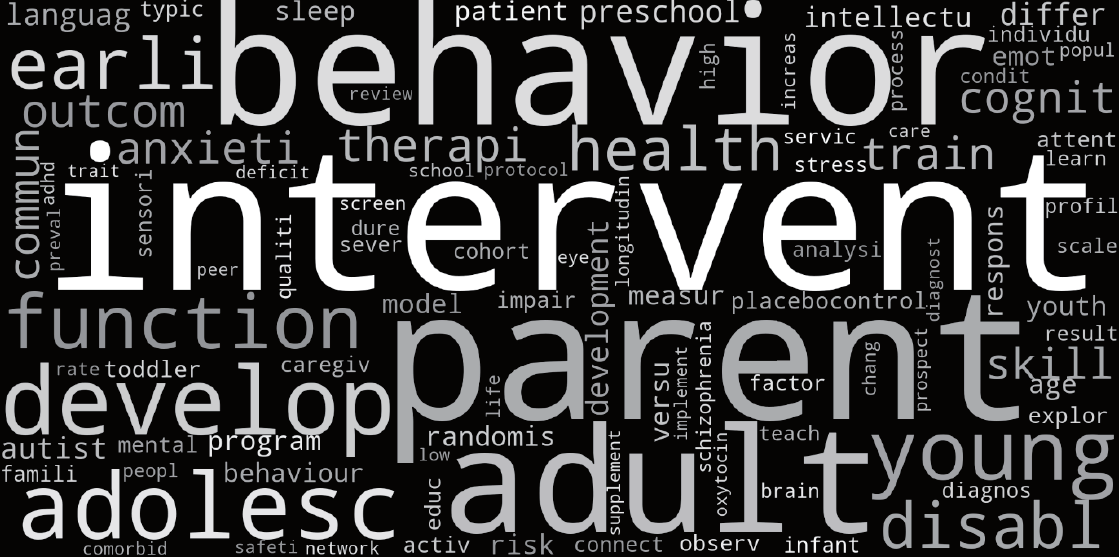Recent trends in autism spectrum disorder research using text mining of PubMed: importance of early detection
Article information
Key message
Behavioral therapy, the most widely proven intervention for the core symptoms of autism spectrum disorder (ASD), is required for life for individuals with ASD. Parent involvement, early detection, and early therapy play important roles. We must organize the risk factors for ASD and develop a screening tool that can be easily applied in the clinical, daycare, or school setting
Despite high global variability, the prevalence of autism spectrum disorder (ASD) has increased in recent years [1]. In the United States, the Autism and Development Disability Monitoring network estimated that the overall prevalence of ASD was about 1.85% among 8-year-olds and 1.56% among 4-year-olds [1]. In Korea, the prevalence of ASD in children younger than 7 years was 1.1% in the development and validation study of the Korean Developmental Screening Test for infants and children [2]. Children and adolescents with ASD require continuous support from their families and society. In the United States, ASD is estimated to affect 1 in 54 children and the lifetime cost for treatment and support is to exceed $7 trillion [3].
To identify the recent trends in ASD research, the author conducted text mining of articles published within the last 3 years (9/1/2017–8/30/2020) in the PubMed database (www.pubmed. gov). Review, meta-analysis, and systematic review articles were excluded. The search query was “(autism spectrum disorder [Title/Abstract]) AND ((“2017/09/01”[Date - Publication]: “2020/08/30”[Date - Publication])) AND (“clinical trial, phase I”[Publication Type] OR “clinical trial, phase ii”[Publication Type] OR “clinical trial, phase iii” [Publication Type] OR “clinical trial, phase iv”[Publication Type] OR “controlled clinical trial” [Publication Type] OR “comparative study”[Publication Type] OR “evaluation studies”[Publication Type] OR “evaluation study” [Publication Type] OR “multicenter study”[Publication Type] OR “observational study”[Publication Type] OR “randomized controlled trial”[Publication Type]).” Text mining was conducted using Python 3.6.5, and its libraries (collections, matplotlib, nltk, pandas, pymed, random, string, and wordcloud). In the pre-processing step, a sentence was decomposed into words, and then, the stems of the words were extracted to prevent redundant counts due to different morphemes. Finally, the word cloud related to the frequency of use was created for visualization.
As a result, 622 abstracts were analyzed. The 10 most frequently used stems in the title are “intervent (frequency of use, #69), parent (#58), behavior (#53), adult (#49), develop (#41), adolesc (#38), young (#36), function (#34), earli (#30), and disable (#27)” (Fig. 1).

Word cloud of the word stem according to frequency in abstract titles about autism spectrum disorder in PubMed published in the past 3 years (9/1/2017–8/30/2020).
This result strongly suggests that behavioral therapy, the most widely proven intervention for core symptoms of ASD, is required throughout an affected individual’s lifetime [3]. It also shows that parent involvement, early detection, and early therapy play important roles [3].
In this context, studies to identify risk factors that are helpful for the early detection and prevention of ASD are ongoing [4].
Perinatal factors that increase the risk of ASD include birth injury or trauma, low birth weight (<2,500 g), cesarean section, and umbilical cord complications [4]. Meconium-stained amniotic fluid (MSAF) is also a debated perinatal risk factor of ASD [5]. The cause of autism cannot be explained by a single perinatal or neonatal factor, and methodological diversity is thought to cause differences in the effects of risk factors across studies [5].
The incidence of MSAF varies from 3% to 27%, occurs predominantly during term and postterm gestation, and is reported in 5% of preterm deliveries [6]. Infants born with MSAF have an incidence of meconium aspiration syndrome (MAS) of 3%–12%. This broad range is partly due to the lack of a widely accepted definition [7].
A previous study has shown that the prognosis of MAS is better than that of meconium staining in terms of ASD [8]. This may be due to the undercoding in neonates with MSAF lacking significant symptoms or censoring due to death or serious neurological complications before the diagnosis of ASD is made. One author hypothesized that this is because therapy for MAS prevents hypoxic brain damage [8]. However, it is difficult to apply this hypothesis immediately to the management of the neonate with MSAF due to insufficient evidence of neurological improvement by MAS therapy and concerns about oxidative stress, barotrauma, and adverse reactions to medications [9].
Notable recent efforts have been made to elucidate the genetic mechanisms of neurodevelopmental disorders (NDD) including ASD. As a result, more than 400 genes related to ASD and NDD were discovered, but the biological mechanisms responsible for these disorders remain unclear [10]. In the near future, we may see advances in the development of precise diagnostic tools and therapeutic interventions driven by emerging technologies and exquisite cellular models of the developing brain.
However, until laboratory advancements are applied to the actual medical field, numerous obstacles will persist. What we should do now is organize the previously identified risk factors and deploy a screening tool that can be easily applied in the national health screening program for infants and children in clinic, daycare, or school settings.
Notes
No potential conflict of interest relevant to this article was reported.
Acknowledgements
Above was results of a study on the "HPC Support" Project, supported by the ‘Ministry of Science and ICT' and NIPA.
